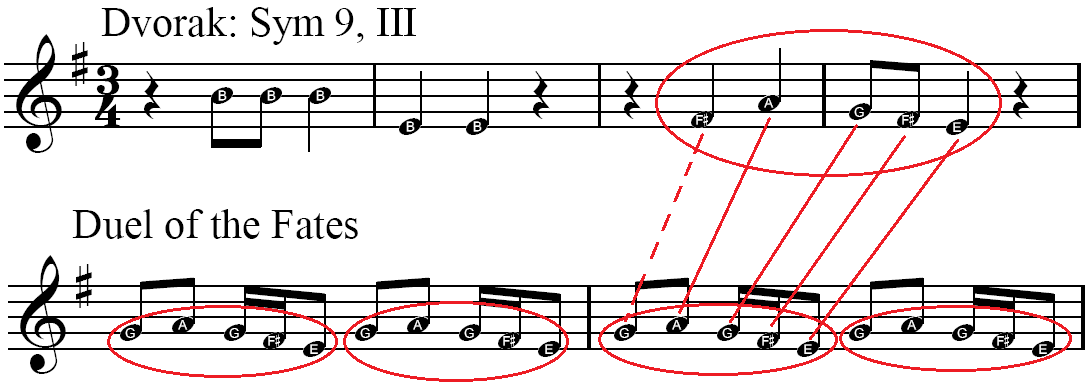|
Although Return of the Jedi used a wordless male chorus to enhance The Sith Theme, The Phantom Menace was the first Star Wars film to feature music with sung lyrics.
John Williams: "The great sword fight at the end of the film - the decision to make that choral was just the result of my thinking that it should have a ritualistic or quasi-religious feeling, and the introduction of a chorus might be just the thing. ... [T]he medium of chorus and orchestra would give us a sense that we're in a big temple." Here are the lyrics in full: Korah Matah Korah Rahtahmah Korah Rahtamah Yoodhah Korah Korah Syahdho Rahtahmah Daanyah Korah Keelah Daanyah Nyohah Keelah Korah Rahtahmah Syadho Keelah Korah Rahtahmah Korah Daanyah Korah Rahtahmah Korah Daanyah Korah Rahtahmah Nyohah Keelah Korah Rahtahmah Syadho Keelah Korah Rahtahmah Korah Korah Matah Korah Rahtahmah Korah Daanyah Korah Rahtahmah Nyohah Keelah Korah Rahtahmah Syadho Keelah Korah Rahtahmah Korah These words originated in the medieval Welsh poem Cad Goddeu (The Battle of the Trees). The text was translated into English by Robert Graves, and published in 1948 as part of The White Goddess: A Historical Grammar of Poetic Myth. John Williams selected lines 32-35: Under the tongue root a fight most dread, and another raging behind in the head I have absolutely no idea what any of the original text means, but Williams had it translated into a variety of languages, eventually selecting Sanskrit "because of the quality of the vowels". If we read between the lines, then, John Williams liked the Sanskrit because it helped provide that "ritualistic or quasi-religious" character that was missing from other languages (and, no doubt, English in particular).
61 Comments
The primary musical contribution in Star Wars, Episode I: The Phantom Menace is the epic "Duel of the Fates", the ostinato of which is likely borrowed from the third movement scherzo of Antonín Dvořák's Symphony No. 9, commonly known as "The New World Symphony". First, here's an excerpt from Star Wars. While the ostinato continues throughout the majority of the track, it is easiest to hear (despite being very quiet) from 0:15 to 0:24. Now compare that with the Dvořák. Here, too, the ostinato is used throughout the majority of the track, but it is easiest to hear at 0:18. While they're clearly not identical (the Dvořák is in triple meter, while the Williams is in duple, and the first half of the Dvořák ostinato has no counterpart in the Williams), the similarities are undeniable: Both are in E minor, using the notes A-G-F#-E consecutively in close but not identical rhythms (indicated in the graphic below with solid red lines). Furthermore, the first note of this pattern is comparable: F# in the Dvořák, compared to G in the Williams - a half step apart, the smallest possible interval (indicated below with the dotted red line). Given all of that, I think it very likely that Williams' temp track for The Phantom Menace included Dvořák's Symphony No. 9.
|
The Music of Star WarsThese posts will help focus and develop my analyses of John Williams' film scores. Archives
December 2019
Categories
All
|



 RSS Feed
RSS Feed
